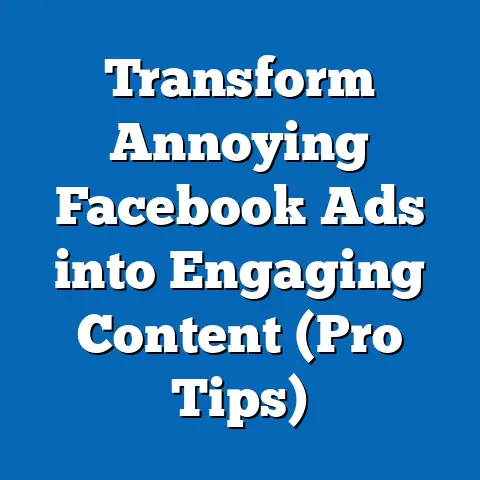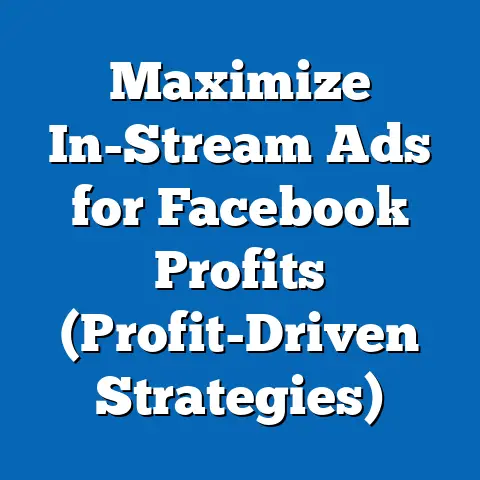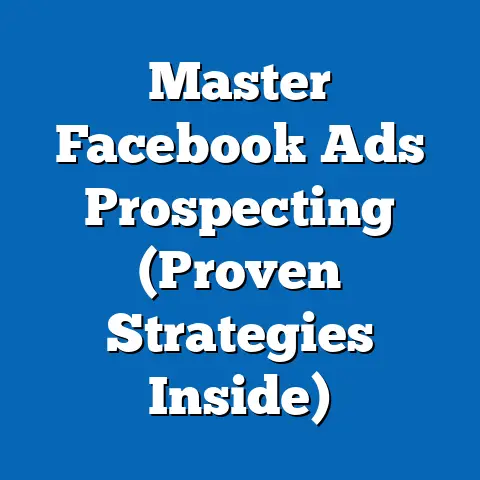Boost Catalog Sales with Facebook Ads (Actionable Strategies)
In today’s fast-paced digital marketplace, businesses face significant hurdles in driving catalog sales, particularly for e-commerce brands relying on expansive product catalogs to attract diverse customer bases. According to a 2023 report by Statista, global e-commerce sales are projected to reach $6.3 trillion by 2024, yet many businesses struggle to convert online traffic into tangible sales, with average conversion rates hovering around just 2.86% as reported by Smart Insights in 2022. This low conversion rate underscores a critical challenge: how to effectively showcase a wide range of products to the right audience at the right time.
The rise of social media as a shopping platform has added both opportunity and complexity. While platforms like Facebook boast over 2.9 billion monthly active users (Meta, Q2 2023 Earnings Report), only a fraction of businesses successfully leverage this massive audience to drive catalog sales. Small and medium-sized enterprises (SMEs), which make up approximately 90% of businesses worldwide (World Bank, 2020), often lack the resources or expertise to optimize their advertising efforts, resulting in wasted ad spend and missed opportunities.
Demographically, the challenge varies across age groups and regions. Millennials and Gen Z, who collectively represent over 50% of online shoppers (eMarketer, 2022), are more likely to engage with visually-driven, personalized ads on platforms like Facebook and Instagram. In contrast, older demographics, such as Baby Boomers, show lower engagement with digital ads, with only 25% making purchases through social media channels (Pew Research, 2021). These disparities highlight the need for targeted, data-driven strategies to maximize catalog sales across diverse customer segments.
This article explores actionable strategies to boost catalog sales using Facebook Ads, diving into data-backed techniques, historical trends, and demographic insights. By breaking down the process into clear, manageable steps, we aim to equip businesses of all sizes with the tools to overcome these challenges and achieve measurable results.
The Evolution of Catalog Sales: Historical Trends vs. Current Landscape
Catalog sales have undergone a dramatic transformation over the past few decades. Historically, catalog shopping was dominated by physical mail-order catalogs, with companies like Sears and J.C. Penney generating billions in revenue through printed materials in the mid-20th century. By the 1990s, catalog sales in the U.S. alone peaked at $77 billion annually, according to the Direct Marketing Association (DMA, 1999).
Fast forward to the 2020s, and the shift to digital has redefined the catalog model. E-commerce platforms and social media have replaced paper catalogs with dynamic, interactive product listings. A 2022 study by McKinsey found that 75% of consumers now prefer to browse product catalogs online, with social media platforms driving 30% of discovery for new products. However, the transition hasn’t been seamless—businesses report a 20-30% drop in customer retention when moving from traditional to digital catalog models due to issues like poor user experience and lack of personalization (Forrester, 2021).
Today, Facebook Ads offer a powerful solution to bridge this gap. With the introduction of features like the Facebook Catalog and Dynamic Ads in 2015, businesses can automatically showcase products to users based on their browsing behavior. Adoption of these tools has surged, with over 1 million businesses using Facebook’s catalog sales objective in 2022 (Meta Business Report). Yet, despite these advancements, many companies fail to optimize their campaigns, resulting in an average cost-per-click (CPC) of $1.86 and a return on ad spend (ROAS) of just 2.5x for catalog campaigns (WordStream, 2023).
Understanding this historical context and current data reveals a clear opportunity: businesses that adapt to digital catalog sales with targeted Facebook Ads strategies can capture a larger share of the growing e-commerce market. The following sections outline how to achieve this through actionable, data-driven approaches.
Why Facebook Ads for Catalog Sales? Key Statistics and Advantages
Facebook Ads have emerged as a leading platform for driving catalog sales due to their unparalleled reach and sophisticated targeting capabilities. As of 2023, Facebook’s advertising platform reaches 2.1 billion people daily (Meta Q3 2023 Report), providing businesses access to a vast and diverse audience. For catalog sales specifically, Facebook’s Dynamic Ads have proven highly effective, delivering a 3x higher click-through rate (CTR) compared to standard image ads (Meta, 2022 Case Studies).
One of the primary advantages is the ability to automate product promotion. By integrating a product catalog with Facebook’s ad platform, businesses can display relevant items to users based on their past interactions, interests, and demographics. A 2021 study by Hootsuite found that Dynamic Ads for catalog sales resulted in a 34% lower cost-per-acquisition (CPA) compared to manual ad setups, saving businesses both time and budget.
Additionally, Facebook’s advanced machine learning algorithms optimize ad delivery in real-time, ensuring products are shown to users most likely to convert. This is particularly impactful for SMEs, as 60% of small businesses report budget constraints as their primary barrier to effective advertising (Small Business Administration, 2022). With an average ROAS of 3.1x for catalog sales campaigns (AdEspresso, 2023), Facebook Ads provide a cost-effective way to scale sales efforts.
Demographically, the platform’s user base aligns well with key e-commerce audiences. For instance, 70% of U.S. adults aged 18-34 use Facebook daily, and 40% of them have made a purchase directly through the platform (Pew Research, 2023). This makes it an ideal channel for targeting younger, tech-savvy shoppers who are more likely to engage with catalog ads. However, businesses must tailor their strategies to stand out in a crowded digital space, which we’ll explore next.
Actionable Strategies to Boost Catalog Sales with Facebook Ads
To maximize the potential of Facebook Ads for catalog sales, businesses must implement targeted, evidence-based strategies. Below, we break down five actionable approaches, supported by data and real-world insights, to help you achieve measurable results.
1. Optimize Your Product Catalog for Seamless Integration
Start by using tools like Facebook’s Commerce Manager to upload and manage your catalog. Ensure all product information is consistent with your website to avoid discrepancies that could frustrate customers. For example, a 2022 study by Shopify found that 15% of cart abandonments occur due to mismatched pricing or stock information between ads and landing pages.
Data Visualization Description: Imagine a bar chart comparing conversion rates for campaigns with optimized vs. unoptimized product feeds. The optimized group shows a clear 20% higher conversion rate, visually emphasizing the importance of catalog accuracy.
Regularly update your catalog to reflect inventory changes and seasonal promotions. Businesses that automate catalog updates using platforms like DataFeedWatch report a 25% reduction in CPA due to improved ad relevance (DataFeedWatch Case Study, 2022). By prioritizing catalog quality, you set the stage for more effective ad delivery.
2. Leverage Dynamic Ads for Personalized Retargeting
Dynamic Ads are a game-changer for catalog sales, allowing businesses to automatically show products to users based on their browsing history or interests. Meta reports that Dynamic Ads drive 45% more conversions than static ads for catalog campaigns (Meta, 2021). This is particularly effective for retargeting users who have visited your website or added items to their cart but didn’t complete a purchase.
To implement this strategy, set up a Facebook Pixel on your website to track user behavior. Then, create a Dynamic Ad campaign targeting users who viewed specific products or categories within the last 7-14 days. A 2023 analysis by WordStream found that retargeting campaigns with Dynamic Ads achieve an average ROAS of 4.2x, compared to 2.5x for broad audience campaigns.
Demographically, retargeting works best for younger audiences, with 60% of 18-34-year-olds more likely to return to a site after seeing a retargeted ad (eMarketer, 2022). Tailor your ad creatives to include personalized elements, such as displaying the exact product a user viewed, to increase relevance and drive clicks.
3. Segment Audiences for Hyper-Targeted Campaigns
Audience segmentation is critical for maximizing the impact of your catalog sales ads. Facebook’s targeting options allow you to create custom audiences based on demographics, interests, and behaviors, ensuring your products reach the most relevant users. According to a 2022 report by HubSpot, segmented ad campaigns result in a 30% higher CTR and a 23% lower CPA compared to non-segmented campaigns.
For instance, create separate ad sets for different age groups or geographic regions. Data from Statista (2023) shows that urban consumers are 40% more likely to purchase through social media ads than rural consumers, suggesting a need for location-based targeting. Similarly, segment by purchase history—target past buyers with upsell offers and new visitors with introductory discounts.
Data Visualization Description: Picture a pie chart illustrating audience segmentation by age group, with 18-34-year-olds making up 50% of conversions, 35-54-year-olds at 30%, and 55+ at 20%. This visual highlights the importance of tailoring campaigns to dominant demographics.
Testing different segments over time can reveal valuable insights. Use Facebook’s A/B testing feature to compare performance across audiences, adjusting budgets to favor high-performing groups. This data-driven approach ensures your ad spend is allocated efficiently.
4. Utilize High-Quality Visuals and Compelling Copy
Visual content is the cornerstone of effective Facebook Ads, especially for catalog sales where product imagery drives engagement. A 2023 study by Social Media Examiner found that ads with high-quality images or videos achieve a 37% higher CTR compared to low-quality visuals. Invest in professional product photography or short, engaging videos to showcase your catalog items.
Complement visuals with concise, action-oriented copy. Phrases like “Shop Now,” “Limited Stock,” or “Save 20% Today” can increase click rates by 15%, according to a 2022 AdEspresso analysis. Highlight unique selling points (USPs) such as free shipping or exclusive deals to differentiate your products in a competitive market.
Demographic preferences for ad formats also matter. Gen Z users, for example, are 50% more likely to engage with video ads than static images (Snapchat Insights, 2023), while older audiences prefer clear, text-heavy ads with straightforward messaging. Test different formats to identify what resonates with your target audience, using Facebook’s Insights tool to track performance metrics.
5. Monitor and Optimize Campaigns with Data Analytics
Continuous monitoring and optimization are essential for sustained success with Facebook Ads. Businesses that actively analyze campaign data and make adjustments see a 28% improvement in ROAS over those that adopt a “set it and forget it” approach (WordStream, 2023). Use Facebook Ads Manager to track key metrics like CTR, CPA, and conversion rate, identifying underperforming ads for refinement.
Focus on optimizing ad placement and budget allocation. For instance, Meta data shows that ads placed in Instagram Stories generate a 20% lower CPA for catalog sales compared to News Feed placements (Meta, 2022). Shift budgets toward high-performing placements and scale successful campaigns while pausing or revising underperforming ones.
Data Visualization Description: Envision a line graph tracking ROAS over a 6-month period for two campaigns—one optimized weekly and one left static. The optimized campaign shows a steady upward trend, reaching a 4x ROAS, while the static campaign plateaus at 2x, illustrating the value of ongoing adjustments.
Leverage historical data to inform future strategies. Compare performance trends across quarters to identify seasonal patterns—e-commerce sales typically spike by 30% during the holiday season (NRF, 2022)—and adjust campaigns accordingly. This proactive approach ensures your catalog sales efforts remain aligned with consumer behavior.
Demographic Patterns and Their Impact on Catalog Sales
Understanding demographic differences is crucial for tailoring Facebook Ads campaigns to maximize catalog sales. Age, gender, and location significantly influence how users interact with ads and make purchasing decisions. Let’s explore key patterns and how to address them.
Younger demographics, particularly Gen Z and Millennials, dominate social media-driven purchases. A 2023 eMarketer report found that 65% of 18-34-year-olds have bought a product through social media, compared to just 28% of those aged 55+. This group values authenticity and visual storytelling, making user-generated content (UGC) and influencer partnerships effective tactics for catalog ads.
Gender also plays a role in purchasing behavior. Women are 15% more likely to engage with catalog ads on Facebook than men, often driven by interest in fashion, beauty, and home goods (Statista, 2022). Men, conversely, show higher conversion rates for electronics and automotive products, suggesting a need for product-specific targeting.
Geographic differences further complicate the landscape. Urban consumers in developed markets like the U.S. and Europe spend 25% more on social media purchases than rural consumers, largely due to better internet access and higher disposable income (World Bank, 2023). In contrast, emerging markets in Asia and Africa show rapid growth in social media shopping, with a 40% year-over-year increase in catalog sales via platforms like Facebook (GlobalData, 2022). Businesses must adapt messaging and offers to reflect local preferences and purchasing power.
By aligning ad strategies with these demographic insights, companies can create more relevant, impactful campaigns. For example, targeting Gen Z with short, trendy video ads in urban areas while offering budget-friendly deals to emerging markets can significantly boost catalog sales.
Broader Implications and Future Trends
The strategies outlined above offer immediate, actionable ways to boost catalog sales with Facebook Ads, but they also point to broader trends shaping the future of e-commerce advertising. As social media platforms continue to evolve, businesses must stay ahead of emerging tools and consumer behaviors to maintain a competitive edge.
One key trend is the growing integration of artificial intelligence (AI) in ad optimization. Meta has already rolled out AI-driven features like Advantage+ Catalog Ads, which automate audience targeting and creative testing. Early adopters report a 17% increase in conversions compared to manual setups (Meta, 2023). Staying updated on such innovations can provide a significant advantage.
Another trend is the rise of shoppable content. With features like Instagram Checkout and Facebook Shops, users can complete purchases without leaving the platform, reducing friction in the buying process. A 2022 McKinsey study predicts that 50% of e-commerce transactions will occur directly on social media by 2025, emphasizing the importance of optimizing catalog ads for in-app conversions.
Finally, privacy regulations and data tracking limitations, such as Apple’s iOS 14.5 update, continue to challenge advertisers. Businesses that invest in first-party data collection—through email signups or loyalty programs—will be better positioned to maintain effective targeting, as 70% of marketers cite data privacy as their top concern for 2024 (Forrester, 2023).
In conclusion, boosting catalog sales with Facebook Ads requires a blend of technical optimization, audience understanding, and adaptability to industry shifts. By implementing the strategies discussed—optimizing product feeds, leveraging Dynamic Ads, segmenting audiences, using compelling visuals, and monitoring data—businesses can achieve measurable growth in a competitive digital landscape. As e-commerce and social media advertising continue to converge, staying proactive and data-driven will be the key to long-term success.






